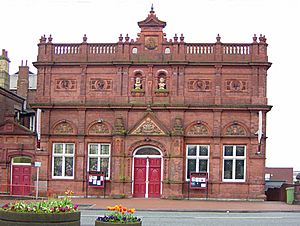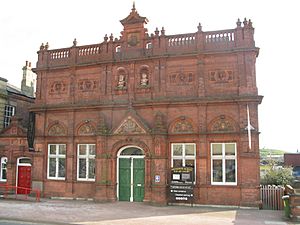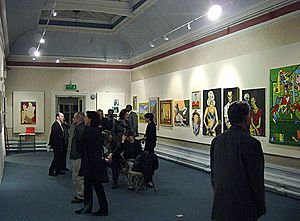Wednesbury Museum and Art Gallery facts for kids
 |
|
| Established | 1891 |
|---|---|
| Location | Wednesbury, West Midlands |
The Wednesbury Museum and Art Gallery is a special art gallery in Wednesbury, England. It was built a long time ago, during the Victorian era. This museum is famous for its amazing collection of Ruskin Pottery. It also hosted the very first public art show for a group called Stuckism.
Contents
The Museum Building
The museum building was finished in 1891. It was built to hold many paintings, drawings, and watercolours. These artworks were given to the town by Mrs. Mary Ann Richards, in memory of her husband, Edwin. The building cost about £5,821 to create.
Who Designed the Building?
The architects who designed the museum were Wood and Kendrick from West Bromwich. Henry Wilcock of Wolverhampton was the builder.
Special Details on the Outside
Look closely at the front of the building! You'll see four special panels. Each panel shows the head of a famous person.
- Sir Christopher Wren represents architecture (building design).
- Sir Joshua Reynolds represents art.
- John Flaxman represents sculpture (making statues).
- Sir Isaac Newton represents science.
Above the main entrance, there are two busts (head and shoulder statues). These are of Alderman Williams and Alderman Lloyd. They were both mayors of Wednesbury and helped lead the Art Gallery Committee.
After World War II
After the Second World War, the museum building was used as offices for a while. But in 1972, it became a museum again. It was updated and made new for visitors.
What You Can See Inside: Permanent Exhibitions
The museum has several exciting displays that are always there for you to explore.
The Ruskin Pottery Collection
Ruskin Pottery is a type of pottery made right here in Sandwell. People from all over the world want to collect it! The pottery on display shows many different kinds of glazes. Glazes are the shiny, colourful coatings on pottery. You can see glazes like Bleu Soufflé, Lustre, Flambé, and Crystalline. They all look very different and beautiful.
The Richards Gallery
This gallery was made especially for the art collection of Edwin and Mary Richards. They lived in Wednesbury and loved collecting art, especially paintings of landscapes. When Mary passed away, she gave their entire collection to the town of Wednesbury.
During the Second World War, these valuable paintings were kept safe in caves in Kinver, Staffordshire. After the war, some of the paintings were put back on display. Today, the collection has fifty-four paintings.
Old Toys and Games
Step back in time in this gallery! It holds toys and games from the Victorian era all the way up to the 20th century. Younger kids (Key Stage 1) can even have fun playing with some of the toys here.
Art by Joseph Gibbs
The museum has a great collection of artworks by a local artist named Joseph Gibbs. One of his paintings is a portrait of Mary Ann Richards, painted in 1891.
The Kilvert Medals
The museum also keeps two special medals that belonged to Alderman John Ashley Kilvert JP. He was a mayor of Wednesbury and fought in the Crimean War. These medals went missing in 1974 and were thought to be stolen.
Years later, a medal collector bought them without knowing they were stolen. After he passed away, his wife put them up for auction. That's when their true origin was discovered! She kindly agreed to give them back to the museum. The museum also has a painting of Alderman Kilvert wearing his official mayor's clothes.
Temporary Exhibitions
The museum often has new and exciting temporary exhibitions. These shows change every six months, so there's always something new to see!
Stuck in Wednesbury
In 2003, the museum hosted an exhibition called Stuck in Wednesbury. This was a very important show because it was the first time the Stuckism art movement had its art displayed in a public gallery.
Bill Viola's Video Art
From July to December 2013, the museum showed works by Bill Viola. He is a famous international video artist. This exhibition was part of a special program with the Tate Gallery and the National Galleries of Scotland. Some of the video artworks on display included Catherine's Rooms, Four Hands, and Surrender.
Portraits from Ingestre Hall
In the first half of 2014, the museum displayed portraits borrowed from Ingestre Hall. This is a beautiful old mansion from the 1600s. It was once the home of important families like the Earls Talbot and the Earls of Shrewsbury.



